
Vernon Eugene Clark is a retired admiral who served as the Chief of Naval Operations (CNO) of the United States Navy. He retired on July 22, 2005, making his tenure of five years the second-longest serving CNO behind Arleigh Burke. He currently sits on the board of directors of Raytheon and SRI International. In November 2009, he was selected along with former Secretary of Veterans Affairs Togo West by Defense Secretary Robert Gates to lead the military investigation into the Fort Hood massacre.

Elmo Russell "Bud" Zumwalt Jr. was a United States Navy officer and the youngest person to serve as Chief of Naval Operations. As an admiral and later the 19th Chief of Naval Operations, Zumwalt played a major role in United States military history, especially during the Vietnam War. A decorated war veteran, Zumwalt reformed United States Navy personnel policies in an effort to improve enlisted life and ease racial tensions. After he retired from a 32-year navy career, he launched an unsuccessful campaign for the United States Senate.

The United States Fleet Forces Command (USFF) is a service component command of the United States Navy that provides naval forces to a wide variety of U.S. forces. The naval resources may be allocated to Combatant Commanders such as United States Northern Command (USNORTHCOM) under the authority of the Secretary of Defense. Originally formed as United States Atlantic Fleet (USLANTFLT) in 1906, it has been an integral part of the defense of the United States of America since the early 20th century. In 2002, the Fleet comprised over 118,000 Navy and Marine Corps personnel serving on 186 ships and in 1,300 aircraft, with an area of responsibility ranging over most of the Atlantic Ocean from the North Pole to the South Pole, the Caribbean Sea, Gulf of Mexico, and the waters of the Pacific Ocean along the coasts of Central and South America.

Harold Rainsford Stark was an officer in the United States Navy during World War I and World War II, who served as the 8th Chief of Naval Operations from August 1, 1939 to March 26, 1942.

Horacio Rivero Jr., was the first Puerto Rican and Hispanic four-star admiral, and the second Hispanic to hold that rank in the modern United States Navy, after the American Civil War Admiral David Glasgow Farragut (1801–1870). After retiring from the Navy, Rivero served as the U.S. Ambassador to Spain (1972–1974), and was also the first Hispanic to hold that position.

John Duncan Bulkeley was a vice admiral in the United States Navy and was one of its most decorated naval officers. Bulkeley received the Medal of Honor for actions in the Pacific Theater during World War II. He was also the PT boat skipper who evacuated General Douglas MacArthur from Corregidor in the Philippines and commanded at the Battle of La Ciotat. The United States Navy named an Arleigh Burke-class guided missile destroyer after him: USS Bulkeley (DDG-84), commissioned in 2001.

William James Crowe Jr. was a United States Navy admiral and diplomat who served as the 11th chairman of the Joint Chiefs of Staff under Presidents Ronald Reagan and George H. W. Bush, and as the ambassador to the United Kingdom and Chair of the Intelligence Oversight Board under President Bill Clinton.
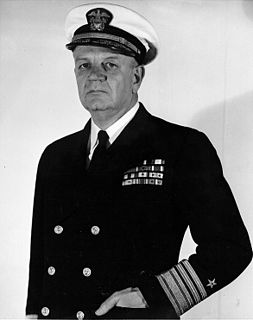
William Morrow Fechteler was an admiral in the United States Navy who served as Chief of Naval Operations during the Eisenhower administration.
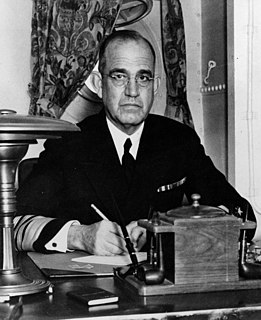
James Otto Richardson was an admiral in the United States Navy who served from 1902 to 1947.

Rear Admiral Draper Laurence Kauffman was an American underwater demolition expert, who served during the 1960s as 44th Superintendent of the United States Naval Academy. During World War II, he organized the first U.S. Navy Combat Demolition Units from which the SEALs would evolve. His wartime service also included participation in the invasions of Saipan, Tinian, Iwo Jima, and Okinawa.
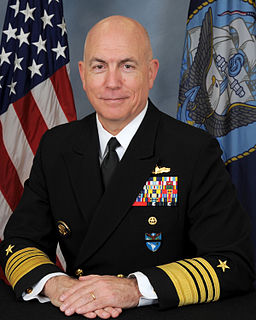
Kurt Walter Tidd is a retired United States Navy admiral. He last served as the Commander, United States Southern Command. Prior to that assignment, Tidd served as Assistant to the Chairman of the Joint Chiefs of Staff. He also served as the Director for Operations, Joint Staff (J-3) from 2012 to 2013, and as Commander, United States Naval Forces Southern Command and United States Fourth Fleet from August 5, 2011 to June 22, 2012. Confirmed by the Senate on December 16, 2015, Tidd received his fourth star and succeeded John F. Kelly as commander of United States Southern Command on January 14, 2016. Tidd held the title of "Old salt", which means he received his qualification for Surface Warfare before any other active-duty navy officer. He passed said title to Admiral Philip S. Davidson upon his retirement. Upon the May 30, 2018, retirement of his United States Naval Academy classmate, Admiral Harry B. Harris Jr., Tidd also gained the honorific of "Old Goat" – the longest-serving Naval Academy graduate on active duty. Harris presented Tidd with the Old Goat decanter in a ceremony on April 11, 2018.

Harry Wilbur Hill was an admiral in the United States Navy during World War II.

Harold Webster Gehman Jr. is a retired United States Navy four-star admiral who served as NATO's Supreme Allied Commander, Atlantic (SACLANT), Commander-in-Chief of the United States Joint Forces Command, one of the United States' Unified Combatant Commands, and Vice Chief of Naval Operations. He was also the Co-Chairman of the Commission that investigated the terrorist attack on the USS Cole and was Chairman of the Columbia Accident Investigation Board (CAIB) after the Space Shuttle Columbia disintegrated during reentry in 2003, killing all seven crew members.

Henry Goodman Chiles Jr. is a retired United States Navy four star admiral who served as Commander in Chief, United States Strategic Command (USCINCSTRAT), from 1994 to 1996, the first naval officer to command all of the strategic nuclear forces of the United States.

Samuel Perez Jr. is a retired Rear Admiral in the United States Navy.
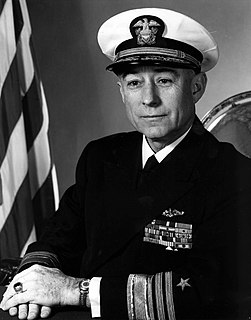
Bernard Lige Austin was a Vice Admiral of the United States Navy. His career included service in World War II, the Korean War, and the Cold War and command of submarines and surface ship forces, during which he became a distinguished combat commander of destroyers. He also commanded the United States Second Fleet, held numerous diplomatic, educational, and administrative staff positions, and a served a lengthy tour of duty as President of the Naval War College.

Vice Admiral Emmett Hulcy Tidd was a flag officer of the United States Navy.
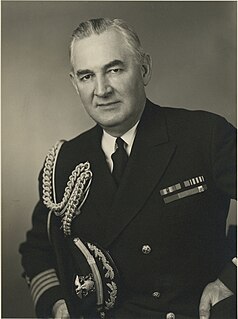
John L. McCrea (1891–1990) was an American naval officer of World War I and World War II, and later an insurance executive.

Lloyd Montague Mustin was a vice admiral in the United States Navy and among the namesakes of USS Mustin (DDG-89). He took part in developing the Navy's first lead-computing anti-aircraft gun sight, which proved of major importance in the air-sea actions of World War II, and he served on the cruiser USS Atlanta during the naval battle of Guadalcanal. His ship was lost during that action, and with other survivors he landed on Guadalcanal and served ashore with a naval unit attached to the First Marine Division. His postwar service included commands at sea and development and evaluation of weapon systems. He later served as director of operations for the Joint Chiefs of Staff during the Vietnam War.

James Henry Doyle, Jr was a vice admiral of the United States Navy, and the son of Vice Admiral James H. Doyle, USN.




















